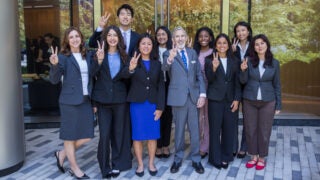Tooth Squad Brings Vital Dental Checkups to L.A. Kids
Studies link oral health to school success, and USC dentists aim to keep children smiling.
Two-year-old Joseph Pacheco shakes his head—a definite “no”—when USC volunteer dentist Vanessa Beer asks him to open wide for a dental screening. Joseph doesn’t know it, but he’s part of an ambitious community intervention by the Ostrow School of Dentistry of USC, which is determined to reach more than 46,000 disadvantaged Los Angeles kids over the next five years and improve their odds of success in life—one healthy smile at a time.
Beer gently encourages Joseph, who squirms in the lap of his mother, Claudia Castellano, at the Women, Infants and Children (WIC) St. Andrews Place Clinic in South LA. Beer introduces Joseph to a friendly stuffed dragon toy and offers him a giant toothbrush to brush the dragon’s teeth. “Fun!” Joseph laughs, and willingly opens his own mouth.
“That’s the kind of reaction we want—a positive experience that will pave the way for lifelong dental visits,” says Michele A. Aeck, clinical professor and outreach director of the Ostrow School’s newest kid-centric program: Children’s Health and Maintenance Project Plus (CHAMP+).
With CHAMP+, the school is getting the word out that the earlier a child sees a dentist, the better. The American Dental Association recommends the first dental visit take place by age 1.
Beer’s advice to Joseph’s mom could shape Joseph’s childhood health and more. She advises Castellano to avoid letting Joseph fall asleep at night with a baby bottle in his mouth—and to replace cavity-producing milk or juice with water. Beer also shows her how to examine her children’s teeth using a plastic dental mirror provided in the goodie bag that each family receives after a visit.
The Ostrow School team also gives her a CHAMP+ card and a list of referrals to community dentists. The goal: to make sure each family finds a permanent “dental home”—an affordable dental office they’ll visit regularly for care and prevention.
“If we can give families with young children information about oral health and help them locate dental homes, we can use education and prevention to stop disease before it starts instead of repairing the damage,” says Roseann Mulligan MS ’87, associate dean for community health programs and hospital affairs at the Ostrow School and principal investigator of the CHAMP+ project.
In 2000, a landmark report by the U.S. Surgeon General concluded that disadvantaged children face a “silent epidemic” in oral health, with dental decay being the single most common childhood disease.
Nearly three of every four disadvantaged children countywide in 2010 had dental caries or tooth decay, according to research by Mulligan and Ostrow School co-investigators Hazem Seirawan MS ’04 (now in private practice) and Sharon Faust. Last year, a follow-up to that study found that kids who reported tooth pain were four times more likely to have a low grade point average and missed significantly more school than children without dental problems. According to the LA Unified School District, dental pain is the No. 1 reason given for absence from school— which influences everything from school funding to test scores.
“Common wisdom tells us that pain leads to poor performance,” Mulligan notes. “Now we have the evidence to prove it and to intervene.”
In its first year, the precursor program to CHAMP+ saw about 3,000 kids. Now the program aims to screen about 15 times that many, thanks to more than $18 million in funding from First 5 LA, a nonprofit organization that invests state tobacco tax revenues in services for children from birth to age 5. USC’s effort is part of First 5 LA’s children’s dental health project, which aims to serve at least 95,000 children and their families in Los Angeles County over the next five years.
It means USC can deploy more teams to screen and teach low-income families about oral health at WIC and Early Head Start centers throughout LA. CHAMP+ teams include dental professionals, promotoras (primarily Latino educators who promote health in the community), benefits enrollment counselors and interns from the USC School of Social Work.
USC dental health advocates will also see patients at a new, four-chair dental clinic at the Los Angeles County+USC Medical Center. The collaboration with the Violence Intervention Program will provide a dental home for 15,000 kids in foster care. The Ostrow School will also ramp up anesthesia services at the dental clinics operated by St. John’s Well Child and Family Centers near USC.
CHAMP+ grew out of the Ostrow School’s longstanding tradition of community involvement, dating back to 1965, when its first community clinic opened after the Watts Riots. The school’s “program on wheels” debuted in 1968 with the USC Mobile Dental Clinic, which travels throughout Central and Southern California. Today, the Ostrow School’s initiative has grown into one of the largest, most robust efforts of any dental school nationwide, delivering more than $7 million in free oral care to people of all ages.
At least 75 percent of its community services target underserved youth. These programs include the USC/QueensCare Mobile Dental Program, a collaboration that brings free comprehensive dental care to low-income children in grades 2-5 in Hollywood elementary schools.
Through the Neighborhood Mobile Dental Clinic—the only preventive mobile program in LA—dental hygiene students visit 15 USC partner elementary schools to offer dental screenings, oral health education and preventive sealants. “For many of these kids, this is their first time in a dental setting—that’s huge,” says Carlos Sanchez ’08, program co-director.
USC experts reach out to community physicians, nurses and dentists with information about the special dental issues of very young kids, in hopes of encouraging more dentists to treat the underserved. This is important because many dentists don’t take the kind of insurance (Denti-Cal) these families can get, so many kids don’t receive the care they need.
The school has also added two more spots in its postdoctoral pediatric dentistry residency program, with the goal of inspiring more students to enter the specialty.
Service to disadvantaged kids and adults is a routine part of clinical training. But Ostrow School students regularly volunteer for community service far above the school’s requirements. And they clearly appreciate the real-world skills they learn. In 2012, 88 percent of graduating seniors ranked community health programs as one of the school’s greatest assets in preparing them to practice.
“Participating in the clinics definitely makes you a better dentist—you gain a better understanding of patients. That’s especially important in working with kids,” says Conan Teng DDS ’13. “Besides, it’s fun!”
Sumeet Srivastava DDS ’13 also volunteered for community programs during his time at USC. For three years, he coordinated the USC Dental Humanitarian Outreach Program, a student-run nonprofit that organizes trips to serve the dental needs of poor communities around the world.
This spring, Srivastava treated a 15-year-old boy who’d been coming to the USC Mobile Dental Clinic since he was 8. At first, the boy had lots of cavities, but now, as a teen, he’s in perfect dental health. And he’s even thinking about going to dental school. “You’re able to have an impact on kids’ futures beyond dental health,” Srivastava says.
Back at the WIC center in South LA, 3-year-old Jasmine Aguilar is contemplating her future. Should she take home a Winnie the Pooh toothbrush or a Toy Story toothbrush after her screening?
She carefully watches Beer, her USC dentist, count the dragon’s teeth. Ten she lets Beer count her own baby teeth, too. After Jasmine’s dad gets a quick lesson on brushing techniques and encouragement to take Jasmine to a community dentist, the little girl jumps of the dentist’s chair. Her decision is made: Winnie the Pooh will be helping her brush her teeth from now on.
Learn more about how Ostrow dentists make a difference.



